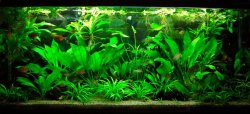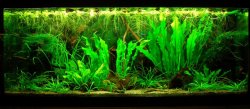NewTankGuy said:
Very interesting Byron!!
With that, I use the Seachem Flourish, Iron, and Trace for my plants. Now the situation I am talking about is in my 75 gal, that is planted. However, in my 29 gal, I have no live plants (yet), so i do not use any of the Flourish line in that tank (so no Excel, Flourish, Iron, or Trace) and that tank has no pH issues at all. Which, being a beginner, is why I thought it must be the Excel, as i seen on other posts people with the same issue stating it was the Excel causing it. Also I thought Excel was a form of CO2, as it says its an "organic carbon" source.
So are you saying that a good idea would be eliminating the use of Excel all together?
in the 75 I have; 6 Angelfish, 5 upside down catfish, 7 Platys, and 6 Cory Cats.
Excel is a bit more complicated chemically. Seachem have tried to explain it so as not to alarm anyone, and this is what they say:
The reason plants need CO2
is to produce longer chain carbon compounds also known as photosynthetic intermediates. Photosynthetic intermediates includes compounds such as ribulose 1,5-bisphosphate, and 2-carboxy-3-keto-D-arabinitol 1,5 bisphosphate. Although the names are complicated, the structures are quite simple (5 carbon chains). Flourish Excel™ does not contain these specific compounds per se, but one that is quite similar. By dosing with Flourish Excel™ you bypass the involvement of CO2 and introduce the already finished, structurally similar compounds. It is in its structural similarity that Flourish Excel™ is able to be utilized in the carbon chain building process of photosynthesis. Simple chemical or enzymatic steps can easily convert it to any one to any one of the above named compounds (or a variety of others).
I use Flourish Comprehensive, Flourish Trace and Flourish Iron myself, and have for several years. Not all tanks get the iron, as it depends upon the plants. I also need to boost the hard minerals as I have zero GH water, so Seachem's Equilibrium is my product for this, but only in three tanks where the larger swords, Aponogeton and Red Tiger Lotus require this increase of primarily calcium. The hard minerals in Flourish Comp is not sufficient to supplement very soft water for some plants.
As for the pH variance between the two tanks, this may be due to the plants. Plus the fish loads, water changes, and GH/KH/pH of your source water. I cannot say more without the data.
To the fish. Except for the platy, you have soft water fish, so lowering the pH to the low 6's is not a problem, once we know why. But you want it to remain there, not be fluctuating; though the fluctuation mentioned if correct is not going to cause issues for these fish. Most aquaria will settle into a biological system that maintains stable (or relative stable) pH. My seven tanks have done this, and the pH is variable among them, Some are in the low 5's or lower, others remain around 6.2 to 6.4, depending upon fish load and plant species. However, your platy are livebearers, and these need some mineral in the water or they can develop internal health issues and usually a much shorter lifespan results. The GH is more important, but pH for these fish should be above 7.
I won't use Excel, as I've explained. It is not necessary, and I see it as a serious risk. Just to illustrate, photos below are two of my planted tanks, with no added CO2 in any form, and the fertilizers previously mentioned.
Byron.

 /fins.actwin.com/mirror/begin-chem.html
/fins.actwin.com/mirror/begin-chem.html

